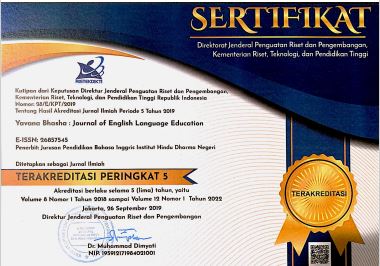ENHANCING STUDENTS’ LISTENING SKILL: LEVERAGING EXTENSIVE LISTENING ACTIVITY IN AN EFL CLASSROOM
DOI:
https://doi.org/10.25078/yb.v6i2.2619Keywords:
teacher education, listening skill, extensive listening, read aloud, repeated listening, narrow listening, vocabulary drilling, speech rateAbstract
This research aims to explore the best implementation of Extensive Listening in improving students’ listening skill at grade eleven of SMK PGRI 3 Badung. The subject of this research is XI MM 2 class that consisted of 31 students. This Classroom Action Research (CAR) cyclic procedure consist of four stages, namely: planning, action, observation, and reflection. Observation and interview was done focusing on how the students respond to the implementation of the extensive listening method, while the test was administered in the end of class to check whether the applied method is effective. The result showed that the best implementation of Extensive Listening was found in the second cycle where drilling vocabulary was applied during pre-listening, practice and adaptation of speech rate were applied in whilst-listening, and exercises were emphasized in post-listening. This syntax was proven to successfully help the students to achieve the learning goal where 96,77% passed the minimum mastery criteria or KKM (75) with the class mean score of 89,67. Besides, students stated that they liked the teaching method and were more motivated in learning listening. Students confirmed that vocabulary and pronunciation drilling was considered effective and influential for their ability in doing the listening test. So, It could be concluded that: 1) drilling vocabulary should be implemented prior to the Extensive Listening main activities to ensure that the students have sufficient vocabulary, 2) teacher should justify the speech rate of the listening material during the Extensive Listening main activities to suit the students’ ability.








